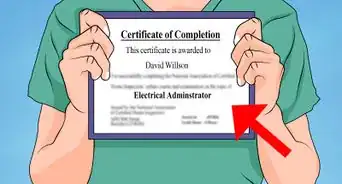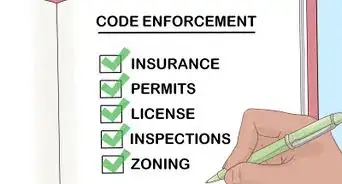This article was co-authored by wikiHow Staff. Our trained team of editors and researchers validate articles for accuracy and comprehensiveness. wikiHow's Content Management Team carefully monitors the work from our editorial staff to ensure that each article is backed by trusted research and meets our high quality standards.
This article has been viewed 29,396 times.
Learn more...
A career as a cable installer can be both challenging and fulfilling. However, while it seems like it is a simple field to get into, there are requirements you need to meet before an employer will consider you for a full-time position. You'll need to meet basic educational requirements, have some level of background in science and electronics, and be interested in the day-to-day responsibilities your job will present. Ultimately, after fulfilling requirements and putting yourself on the path to be an installer, you'll have a good chance of securing a position.
Steps
Meeting the Requirements
-
1Obtain a high school diploma. Almost all cable installer jobs will require you to have at least a high school diploma. Without a diploma, you'll be ill-prepared for the rigors of the job.
- A GED provides you with the same qualification as a high school diploma.
- If you don't have a diploma, consider taking night classes to earn your GED.[1]
-
2Enroll in a technical program. Locate a telecommunications or communications technical program at a traditional or online college. There are a wide variety of programs available that will prepare you with the knowledge you'll need to be a cable installer.
- Consider Job Corps' "Network Cable Installation" career pathway program. This is an 8 to 12 month program in which you will be educated and trained to become a cable installer.
- Many technical colleges and community colleges have telecommunications installation programs you can enroll in. These are typically 1 to 2 year programs from which you will earn either a certificate or a diploma.
- In some cases, you may consider taking individual higher education courses so you can gain familiarity with a given subject. Remember, though, employers may prefer candidates who have completed a certificate program or have earned a diploma.
Advertisement -
3Take classes on science and technology. When enrolled in a certification or technical program, you'll have to gain a mastery of a variety of subject areas. Without this information, you won't have the basic skills or have the theoretical framework you need to succeed as a cable installer.
- You'll need to gain a familiarity with subjects like the properties of electricity and electronics, electrical engineering, and sciences like physics.[2]
-
4Take advantage of an internship or apprenticeship program. After you have your basic educational courses, you'll need experiences to move up in your career as a cable installer. With interning or apprenticing experience, a cable provider will be much more likely to higher you.
- Most companies have established programs. If they don't, you can call the company and arrange a time to meet with a technician to get some hands-on experience.
- Spend at least three to four months under the supervision of an installer or a technician getting hands-on experience.
- While apprenticeships were once very common, they are increasingly rare as many cable installers are often employed in entry level jobs at low pay before advancing.[3]
-
5Maintain a clean driving records. Another important requirement to be a cable installer is to make sure you have a good driving record. This is important, as cable installers are constantly on the road driving from service location to service location.
- If you have convictions for DUIs or reckless driving on your record, employers may not hire you. This is especially true if you are applying for a salaried job, where you will be driving a vehicle owned by the company.
- Consult a lawyer if you want to try to have your driving record expunged.
Getting a Job
-
1Search for positions. Once you've met basic requirements, you need to start a job search. While you can limit your search to the city or region you live in, you may want to consider a statewide or even national search.
- Visit websites like Monster.com or Indeed.com to find job postings.
- Find out the names of cable companies or contracting firms in your region and visit their employment webpage.
- Pay may vary based on region. For example, some high demand areas may have more opportunities and higher pay.
- Look for a full-time position as a salaried employee of a cable company.
- Apply for a job as a contractor for a cable company or a subcontractor.[4]
-
2Apply for jobs. Once you've found jobs to apply for, you'll need to successfully complete any application paperwork.
- Contractor jobs may have less paperwork associated with them, since you won't be a salaried employee eligible for benefits.
- Supply a list of references. References may include professors, mentors, or past supervisors.
- Complete the employment application. You'll need to provide your full name, social security number, phone number, home address, and more.
-
3Prepare for your interview. If a cable company or contracting firm contacts you after you've submitted your application, you'll need to prepare yourself for a face-to-face interview.
- Do a little research about the company. Know the scope and size of their operations.
- Speak slowly, confidently, and try not to let your nerves or anxiety get the best of you.
- Make sure to prepare yourself physically for the interview. You should shower, groom yourself, and wear freshly pressed professional cloths -- like a dress or a suit.
- Be ready to answer questions about your education or experience. For instance, an employer might question you about challenging installation jobs you had in the past.[5]
Learning About a Career as a Cable Installer
-
1Know the benefits of the job. Cable installers enjoy a variety of benefits in terms of compensation and time on the job. Some benefits include:
- You usually won't have to work in an office setting, and will get the opportunity to travel widely in your community.
- Your employer may provide you with safety equipment and tools.
- Your employer will provide you with training opportunities.
- The medium income is about $54,000 in the United States. This is $19,000 higher than average incomes for people with a high school education.[6]
-
2Accept career challenges. When becoming a cable installer, you need to be ready for a variety of challenges you'll encounter on a day-to-day basis. Ultimately, you need to be knowledgeable about these challenges before you decide to apply for a job.
- There is a chance you will have to travel long distances.
- You may have to work irregular hours, overtime, nights and weekends, or holidays.
- You will very often have to work in confined spaces, work on ladders or in the air, or in other challenging environments.[7]
-
3Educate yourself about career advancement. One of the good things about a career as a cable installer is the opportunity for advancement. Not only can you make decent money as a cable installer, but you can move up in the organization you work for and take on new and challenging jobs. Some opportunities for advancement include:
- Industrial or site-based telecommunications jobs. These jobs usually pay more and only include limited travel.
- Training jobs. If you get promoted to a trainer, your pay will increase and you won't have to spend much time in the field.
- Manager positions. With enough experience, you may eventually be promoted to a management role.[8]
References
- ↑ http://collegemouse.com/jobs/how-to-become-a-cable-technician.html
- ↑ http://collegemouse.com/jobs/how-to-become-a-cable-technician.html
- ↑ http://www.calapprenticeship.org/programs/communications_apprenticeship.php
- ↑ http://www.slate.com/articles/business/the_grind/2016/04/more_cable_and_internet_installers_are_independent_contractors_and_the_hours.html
- ↑ https://www.monster.com/career-advice/article/what-if-your-interview-is-tomorrow
- ↑ http://learningpath.org/articles/Becoming_a_Cable_Installer_Job_Description_Salary_Information.html
- ↑ http://learningpath.org/articles/Becoming_a_Cable_Installer_Job_Description_Salary_Information.html
- ↑ http://learningpath.org/articles/Becoming_a_Cable_Installer_Job_Description_Salary_Information.html























-Step-17.webp)









































